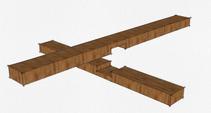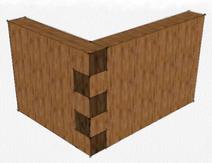Furniture Construction Joints
Frame Joints |
The following images are of different timber joints used in furniture frame construction.
|
Corner Halved JointThe Corner Halved joint are one of the most simplest ways to join two pieces of timber together with minimum labour. This type of joint would be used for the corners of frames and supports both for internal and external application. Nails and glue would be added to support the hold of the join.
|
Crossed Halved JointThe crossed halved joint is like the corner halved joint. A simple way to join two pieces of timber together except this type would be commonly used for support and frame construction supplying strength to the frame. It is also used for internal and external application. Like the corner halved joint this one also requires glue and nails to hold.
|
Mortise and TenonThis is a common joint used in the frames of such objects as tables. There is a common rule to creating this joint: the tenon (the piece cut to fit the second) should be cut at 1/3 of the thickness of the timber. This allows for the join to be equally strong on all sides. This type of joint would also require glue to assist the hold.
|
Dovetail JointThe Dovetail Joint is one of the most complex and strongest joins available. The type of applications consist of draw frames and plinthes. It is noted for not easily being pulled apart like other types of joints. There are many variations of the joint and the one shown is the most simplest and common. It is said to be inspired by the tails of Doves. They also have an aesthetic strength. Glue would assist in the joints hold.
|
Widening Joints |
The following images are of different timber joints used in furniture construction to widen the timber.
|
Dowel JointThe dowel Joint is a common and reasonably easy way to widen timber. Most of the applications a widening joint would be used for is table tops. Using smaller widths in timber can be cost effective as wider cuts tend to be extremely expensive and harder to find. Glue would be required to be inserted into the holes that house the dowel as well as the surrounding timber. An important note is that the dowel pieces do not fit perfectly in the holes that house them as there must be room for expansion.
|
Biscuit JointSimilar to the Dowel joint the Biscuit joint has the same purpose. This type of joint would be made through the use of a biscuit jointer—an electric hand held machine. The machine cuts out a hole in the timber not to similar to the biscuit shape, hence the name. As the dowel joint it is required glue in the holes as well as the surround timber.
|
Tongue and Groove JointThe most common place to see a tongue and Groove joint is in timber flooring. It is treated like a locking mechanism to hold all of the pieces of timber together. Again like the Mortise and Tenon joint this one has a rule. It is also 1/3 of the thickness to be cut for the groove. Only glue is required to hold these together.
|












